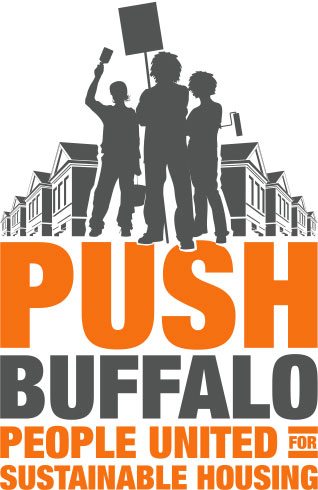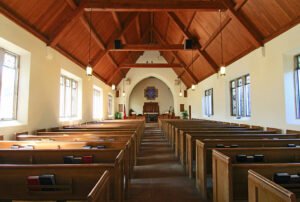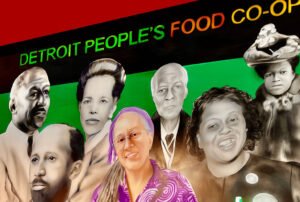
December 4, 2017; Next City
In July 2016, the New York Daily News ran a profile on Buffalo. It began:
From its booming city center to its buzzing West Side, Buffalo—once considered too dicey to even walk around—feels like a city on the cusp of something big.
Abandoned industrial sites are getting transformed into nightlife venues. Young chefs are heating up a restaurant scene that’s both adventurous and unpretentious. A long-neglected waterfront has been reborn as Canalside, a 21-acre park with concerts, sporting events, festivals, and a sandy playground for kids. It’s a brilliant reclamation of the majestic Erie Canal.
And the unthinkable is happening in Buffalo’s underappreciated downtown: People are choosing to live there.
But how do long-time residents on that “buzzing” West Side feel? As Danya Sherman reports, “with West Side residents these days, one common theme often emerges: fear of displacement.”
On Buffalo’s West Side, a nonprofit called PUSH Buffalo (People United for Sustainable Housing) has emerged as a community leader. “With a structure unique among community development organizations, the $3 million-a-year nonprofit,” Sherman writes, “is a housing developer, political organizing group, workforce development agency, arts hub, green energy firm and more.”
PUSH’s range, Sherman points out, has helped it diversify funding “with 30 percent of its operating budget coming from green energy work and another 15 percent coming from other sources of earned revenue.” PUSH has grown quickly, from a staff of six in 2006 to over 50. It also has hundreds of members, who pay $5 dues each to the organization.
Johanna Walczyk of LISC (Local Initiatives Support Corporation) Buffalo remarks that, “PUSH’s work has been a gold standard in comprehensive community development work.” LISC Buffalo, Sherman notes, has partnered with PUSH on many projects over the years.
Among PUSH’s achievements is the development of a 25-block area (first set up in 2008) known as a “Green Development Zone,” which has been a focus area of housing, workforce and environmental development.
Sign up for our free newsletters
Subscribe to NPQ's newsletters to have our top stories delivered directly to your inbox.
By signing up, you agree to our privacy policy and terms of use, and to receive messages from NPQ and our partners.
Sherman adds:
Guided by a collaborative community plan for the neighborhood, PUSH recently broke ground on another major project on the West Side: the redevelopment of a shuttered public school into a community anchor with affordable apartments for seniors, a youth community center and gym, office space for PUSH, and a home for the Ujima Theatre Company. Solar energy will power the School 77 building. Elsewhere in the city, PUSH is supporting a fledgling community land trust and working with the state on a green energy job training program, and is part of a coalition advocating for citywide affordable housing policies.
Buffalo, however, still faces some harsh realities. A third of the city’s households, notes Sherman “live on $20,000 per year or less, while rents “have increased 8 to 13 percent annually over the past decade.”
Most everyone agrees that the lack of affordability is intolerable. The mayor’s office has released its Housing Opportunity Strategy. Community groups—led by two PUSH allies, the Partnership for Public Good and Open Buffalo—have released their own strategy. As Sherman observes, there are key differences: “while the city recommends a citywide trust, the local nonprofits advocate for neighborhood-specific initiatives led by residents.” The community report also called for more Green Development Zones throughout the city.
PUSH’s history, Sherman explains, has involved previous struggles. Early on, Sherman notes, organizers came together “to prevent New York’s Housing Agency from using a fraudulent bundled bond to speculate on the deeds for nearly 1,500 tax-delinquent vacant lots throughout the city—200 of which were on the West Side. After a direct-action campaign targeting then-Governor George Pataki brought the issue to light, the incoming Eliot Spitzer administration worked with PUSH to unravel the bond and transfer the properties back to the city. Several of these properties were ultimately transferred to PUSH.”
Today, Sherman adds, PUSH through its Buffalo Neighborhood Stabilization Corporation wing “manages 77 apartments in 26 buildings…there’s another 44 under construction. PUSH also operates a “Push Green initiative” that “trains and places workers in green construction trades and offers solar installation, weatherization, and services to homeowners and companies.”
Community control of land and community organizing have always been central to PUSH’s approach. “One-on-one relationships built through door knocking and outreach create a foundation for operations with a strategy for community input and democratized decision-making feeding all aspects of the organization, including overall governance through the board of directors,” writes Sherman.
PUSH’s example has also spurred organizing on Buffalo’s East Side. The Fruit Belt neighborhood, once home to German and Polish immigrants, today is 83 percent Black, with a median household income of $20,047. A new organization, the Fruit Belt Community Land Trust (FBCLT), Sherman writes, “identified 200 city-owned properties in the nine-block neighborhood and [has] begun advocating for their transfer to the nascent trust.”
Henry Louis Taylor Jr., an urban studies professor at the University of Buffalo, contends that a community-led strategy can work: “If you play the long game in neighborhood revitalization,” Taylor says, “costs go down when equitable investments are made.”
Harper Bishop, one of the organizers behind the FBCLT and the economic and climate justice coordinator for Open Buffalo, adds, “Every time we challenge the structure, new political realities that seemed impossible become plausible.”—Steve Dubb















